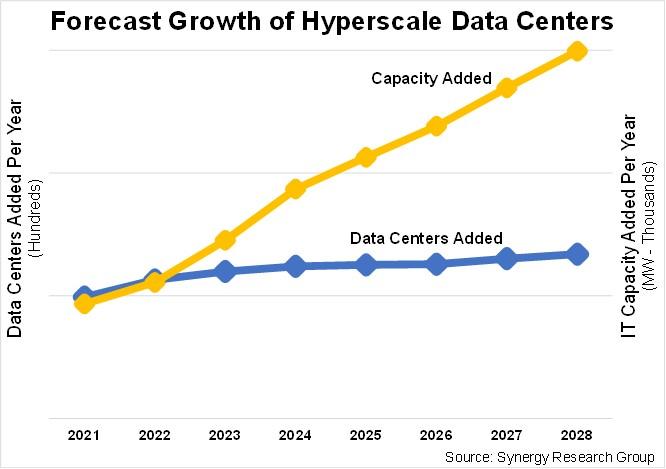-
A new forecast from Synergy Research Group shows the top hyperscalers are planning to build hundreds of new data centers by 2028
-
But the new data centers aren't the only thing driving capacity growth - AI is set to play a huge role
-
The trend will impact colocation providers as well, though not to the same degree
The top 19 hyperscale companies are set to add at least 427 new data centers over the coming five years, increasing the total among those providers to 1,353. That’s pretty significant growth, but the amount of capacity available in those facilities is set to skyrocket, growing threefold over the same timeframe, new data from Synergy Research Group showed.
According to the firm, this rapid growth is a function of a combination of factors related to artificial intelligence (AI). First, while it’s normal for the average IT load within data centers to grow over time, AI is supercharging this trend. Second, it’s not just new data centers that will have more capacity. Synergy noted “there will also be some degree of retrofitting” in existing data centers as well with GPU chips to meet the needs of AI workloads.
If numbers aren’t your thing, check out this chart to get a better idea of what we’re talking about.

Synergy’s forecast was based on the firm’s analysis of 19 major global cloud providers and ISPs. But Synergy’s Chief Analyst and Research Director John Dinsdale told Silverlinings other players in the market will also feel the impact of capacity growth.
“Colo[cation] operators essentially rent space and power and not servers or GPUs. It is their customers who put their owned equipment into the colocation data centers,” he explained. Thus, “the impact on colo companies is that they have to be able to provide enhanced power capabilities in their facilities. That will be an across-the-board issue, but particularly acute for their hyperscale operator clients.”
Hmmm, sound familiar? That’s probably because we’ve talked about the power issue before.
The TL;DR version is that GPUs require more power and data center operators are trying to cram more of them in each rack. That means that each data center as a whole needs to have more power run to it. But there are some hiccups, as utility companies in some places just can’t keep up with demand. You can read more on that here.